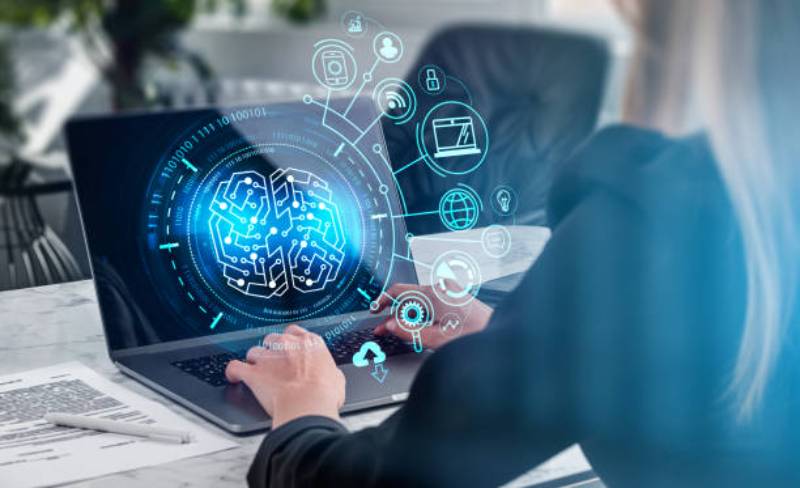
How Artificial Intelligence Is Redefining Workplace Productivity
10 min read
12 Oct 2025
Introduction
Artificial Intelligence (AI) is no longer a futuristic concept—it is an active force reshaping how organizations function, communicate, and thrive in today’s competitive environment. Across industries, AI is being leveraged to automate repetitive tasks, enhance decision-making, and improve collaboration among teams. The question is not whether AI is influencing workplace productivity, but how deeply it is transforming the very foundation of how we work. With every passing year, AI’s influence expands, making it a cornerstone of modern business strategy.
The Evolution of AI in the Workplace
From early automation tools in the 1980s to today’s advanced machine learning systems, AI has evolved into a robust productivity partner. Businesses once used AI primarily for data entry or routine operations, but modern systems now assist in analytics, customer service, HR, and even creative problem-solving. This evolution demonstrates that AI is not only making work faster but also smarter. The continuous refinement of AI algorithms allows businesses to stay ahead of competition and anticipate customer needs more effectively.
World Economic Forum on AI in the WorkplaceAI-Powered Automation
- Automating repetitive administrative tasks such as scheduling, payroll, and report generation.
- Streamlining supply chain operations with predictive analytics.
- Using robotic process automation (RPA) to minimize human errors.
- Freeing up employees from monotonous data-entry work so they can focus on innovation and strategy.
AI tools like UiPath and Blue Prism have shown how automation reduces costs and saves employees countless hours. By removing mundane tasks, employees can focus on higher-value strategic work. This not only drives productivity but also boosts morale as workers feel empowered to engage in more meaningful roles.
Enhancing Decision-Making with AI
AI analytics platforms such as IBM Watson and Google Cloud AI help leaders process large data sets within seconds. Insights that once took weeks of analysis can now be delivered instantly, helping businesses respond to market shifts with agility. Predictive models identify patterns, forecast outcomes, and enable better risk management. The integration of real-time dashboards and visualization tools ensures that decision-makers have all the information they need at their fingertips.
AI in Communication and Collaboration
- Smart assistants like Microsoft Copilot and Google Duet enhance productivity in documents, emails, and presentations.
- AI chatbots streamline internal communications and HR queries.
- Real-time transcription and language translation tools remove communication barriers.
- AI-driven scheduling tools ensure efficient allocation of time and resources.
AI and Employee Experience
AI is also redefining the employee experience. Personalized training platforms powered by AI assess skill gaps and recommend courses, while wellness apps monitor stress levels and encourage work-life balance. This not only improves productivity but also fosters long-term employee satisfaction. Companies that invest in AI-driven employee engagement platforms often report lower turnover rates and higher innovation levels.
Case Study: AI in Remote Work
- Zoom’s AI Companion assists in meeting summarization.
- AI scheduling assistants manage time zones for global teams.
- Virtual collaboration platforms use machine learning to recommend best practices for distributed teams.
- AI-based project management tools assign tasks based on employee skill sets and workload balance.
These innovations ensure that remote and hybrid workplaces remain equally or more productive than traditional office setups. By enabling seamless collaboration across geographies, AI helps organizations unlock global talent potential.
The Role of AI in Customer Service
AI chatbots and voice assistants are available 24/7, providing instant responses to customer queries. This reduces workload on human representatives and improves customer satisfaction. Companies like Amazon and Shopify use AI-powered bots to handle millions of queries daily. AI doesn’t just provide responses; it learns from interactions, continually improving its ability to resolve issues faster and more effectively.
AI in Recruitment and HR
- Automated resume screening accelerates the hiring process.
- Predictive analytics assess employee performance trends.
- Sentiment analysis helps HR leaders gauge employee engagement.
- AI helps create unbiased job descriptions to attract diverse candidates.
AI recruitment platforms like HireVue use natural language processing to evaluate candidates fairly, reducing unconscious bias in hiring decisions. In addition, AI-enabled platforms can suggest career development paths for employees, creating a stronger organizational culture.
External References
Ethical Considerations
While AI boosts productivity, concerns about privacy, surveillance, and bias remain. Employees worry about job displacement, while managers must ensure AI tools are transparent and ethical. Striking the right balance between efficiency and fairness is critical. The future of AI requires thoughtful regulation and ethical frameworks to ensure human dignity remains central.
Future of AI in Workplace Productivity
Experts predict that AI will shift from being an assistant to a true collaborator. AI will not just recommend actions but co-create solutions with humans. By 2030, many workplaces will see AI and human teams working side by side, enhancing creativity and innovation. The real breakthrough will come when AI systems can understand context, emotions, and cultural nuances, making them even more effective collaborators.
Key Benefits of AI in Workplace Productivity
- Reduces operational costs.
- Saves time through automation.
- Enhances decision-making accuracy.
- Improves communication and collaboration.
- Supports employee growth and satisfaction.
- Helps organizations remain agile and competitive.

Challenges to Overcome
- Data privacy and security risks.
- The potential for job displacement.
- Need for upskilling and reskilling employees.
- Ensuring fairness in AI algorithms.
- Building trust among employees about AI adoption.
Internal Links for Further Reading
Conclusion
Artificial Intelligence is no longer just a supporting tool—it has become a productivity powerhouse. From automating repetitive tasks to enabling smarter decision-making, AI is reshaping every corner of the modern workplace. Businesses that embrace AI responsibly will not only gain efficiency but also build more engaged, innovative, and future-ready teams. The true power of AI lies in augmenting human capabilities, not replacing them. By fostering collaboration between human creativity and machine intelligence, organizations can unlock unprecedented levels of productivity and innovation.
FAQs
How does AI improve workplace productivity?
AI improves workplace productivity by automating repetitive tasks, analyzing data faster than humans, and providing actionable insights for decision-making. It enhances collaboration through smart tools, supports employee training, and streamlines workflows. By minimizing manual operations, AI allows employees to focus on creativity, strategy, and problem-solving, leading to measurable gains in efficiency and business growth.
Will AI replace jobs in the future?
AI will replace some repetitive and process-driven roles but will simultaneously create opportunities in areas such as AI development, data management, and human-AI collaboration. Rather than eliminating work, it reshapes industries. The future workforce will emphasize reskilling, adaptability, and leveraging AI as a supportive tool, ensuring humans and machines complement one another instead of competing.
What are some examples of AI tools for productivity?
Popular AI tools include Microsoft Copilot for office tasks, Google Duet for collaboration, and UiPath for process automation. In HR, platforms like HireVue streamline recruitment. AI-powered project management systems optimize workload distribution, while transcription, translation, and data analytics tools enhance daily operations. These innovations help businesses save time, improve quality, and strengthen workplace productivity significantly.
Is AI adoption cost-effective for small businesses?
Yes, AI adoption is increasingly affordable for small businesses. Cloud-based AI platforms offer scalable services, from automation and analytics to customer support chatbots, at manageable costs. These tools reduce labor expenses, streamline workflows, and help small firms compete with larger enterprises. Lower entry barriers make AI accessible, enabling smaller businesses to achieve efficiency and innovation.
What challenges do companies face when adopting AI?
Companies adopting AI face challenges such as data privacy issues, algorithmic bias, and high initial costs. Employee resistance due to job security concerns also exists. Overcoming these requires strong AI governance, transparent communication, and employee training. Organizations must prioritize ethical implementation, ensure compliance with regulations, and create a supportive culture to maximize AI’s long-term benefits.
How can employees adapt to an AI-driven workplace?
Employees can adapt by engaging in continuous learning, improving digital literacy, and gaining proficiency with AI tools. Upskilling in data analysis, automation platforms, and AI-driven collaboration systems builds resilience. Developing soft skills like emotional intelligence, creativity, and leadership further strengthens adaptability. Companies can support employees by offering AI-focused training programs that prepare them for evolving roles.
What industries benefit the most from AI productivity tools?
Industries such as healthcare, finance, logistics, retail, and customer service gain major advantages from AI productivity tools. Healthcare uses AI for diagnostics and patient monitoring, finance benefits from fraud detection and portfolio management, and logistics optimizes supply chains. Retail enjoys personalized shopping experiences, while customer service leverages chatbots and virtual assistants to improve efficiency and satisfaction.
Is AI safe to rely on for decision-making?
AI can support decision-making effectively when paired with human oversight. It processes vast data sets quickly and provides accurate insights, but limitations such as lack of context, ethical reasoning, or empathy remain. Businesses must ensure human judgment balances AI output. Responsible governance, transparency, and accountability are essential to make AI-assisted decisions safe, reliable, and fair.

The AR Breakthrough That Will Make Blockchain Transactions Simpler Than Ever!
6 min read | 11 Oct 2025
How AI Is Making Blockchain Smarter and Safer – The Inside Scoop!
5 min read | 10 Oct 2025
The Big Tech Twist: How VR Is Set to Disrupt Blockchain Like Never Before!
6 min read | 09 Oct 2025
Unlocking the Power of AR: How Augmented Reality Is Set to Revolutionize Blockchain!
5 min read | 08 Oct 2025More Articles

Machine Learning Algorithms: An Overview of Popular Techniques and Their Applications
5 min read | 03 Sep 2025

AI and the Creative Arts: Exploring Machine Generated Music and Art
6 min read | 02 Sep 2025

AI in Education: Personalized Learning and Intelligent Tutoring Systems
5 min read | 01 Sep 2025

The Impact of AI on Employment: Job Displacement vs. Job Creation
6 min read | 31 Aug 2025
More Articles

Customization Unleashed: Exploring the Best Android Launchers of 2024
7 min read | 07 Jun 2025

Android 13: What to Expect from Google's Next Mobile OS Iteration
7 min read | 06 Jun 2025

The Future of Augmented Reality: Apple's Vision with ARKit and AR Glasses
5 min read | 05 Jun 2025

Exploring the Evolution of Apple Watch: From Fitness Tracker to Health Companion
5 min read | 04 Jun 2025
